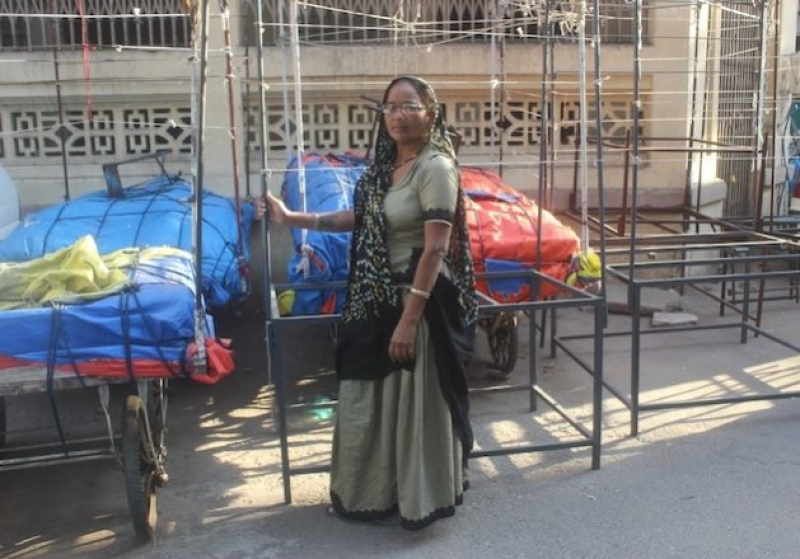- UNRWA Situation Report on Crisis in Gaza & Occupied West Bank |
- Intimidation or bloodshed cannot halt Bangladesh’s march to democracy |
- Khaleda Zia integral to an important chapter in BD history: Yunus |
- Enthusiasm marks Victory Day celebrations across Bangladesh |
- Dhaka-Delhi ties deep; to be shaped by trust, dignity, mutual respect |
Heat insurance cushions India's poorest women from losses

Street vendor Deviben Dhaundhaliya waits by her iron-frame mobile ‘shop’ to be shifted to the marketplace for evening-time sales in Ahmedabad city in Gujarat state.
As Deviben Dhaundhaliya, 45, a streetside seller of artificial jewellery, waits for her husband Devabhai to help her move their iron-frame mobile ‘shop’ to the Bhadra Fort open-air market in Ahmedabad, she shares how rising heat affects her livelihood.
“As heat increased, my wares began melting under direct sunlight or became discoloured,” she says.
This isn’t new—Deviben has faced heat damage nearly every year since Ahmedabad suffered a deadly heatwave in May 2010, with temperatures reaching 46.8°C. Now, she says, “For over a decade, our income plummets, and sickness stalks us through the hottest months.”
But a new form of income protection—parametric microinsurance—offers a safety net to self-employed women like Deviben. Designed for the informal sector, it helps them cope with the rising threat of extreme heat in India.
Unlike traditional insurance, parametric insurance pays out when specific thresholds (like temperature levels) are reached, eliminating the need for lengthy damage assessments. These policies often involve lower premiums—initially subsidised—and provide quick payouts.
“Livelihoods and incomes drop by 30–50 percent due to reduced work efficiency, shorter work hours, increased costs, spoilage of goods, and heat-related illnesses,” says Sahil Hebbar, Senior Coordinator of the parametric pilot at the Self-Employed Women’s Association (SEWA).
According to the World Meteorological Organization (WMO), Asia’s average temperature in 2024 was 1.04°C above the 1991–2020 average, ranking it among the warmest years on record. The region is warming nearly twice as fast as the global average, increasing extreme weather risks.
Extreme heat, a leading climate risk, causes nearly half a million deaths annually. Globally, it results in 675 billion lost work hours every year, or roughly 1.7% of global GDP, according to Swiss Re, which partnered with SEWA in 2024.
Women in Informal Employment Face Disproportionate Heat Risks
Roughly 90% of women workers in India are in the informal sector. When heat prevents them from working, they lose their wages entirely. Developing countries are particularly vulnerable to climate shocks, and women bear the brunt.
SEWA represents 2.9 million such women: salt pan workers, recyclers, street vendors, farmers, and home-based labourers. Their daily wages range from 150 to 450 rupees (USD 1.74–5.22).
Deviben sells fibre bangles and jewellery, often under the scorching sun. “Dehydration is common. Sometimes I feel dizzy. I take shelter under a tree but only briefly, or I risk losing customers,” she says.
She occasionally buys Oral Rehydration Solution but can’t always afford the 20 rupees (USD 0.23).
Hansaben Ahir, 49, a waste recycler, says she suffers from UTIs, heat cramps, and hypertension worsened by financial stress. “From late March to June, my earnings drop to just half—250 rupees a day,” she adds.
Out-of-pocket medical expenses drain what little they save. “The insurance payout helps cover these costs,” Deviben says.
SEWA’s 2023 pilot didn’t trigger payouts because the temperature threshold was too high (three consecutive days over 45–46°C). Yet, lessons were learned.
Sahil Hebbar, also a consulting physician with SEWA, explains that satellite-recorded temperatures may not match actual ground-level heat where workers are exposed. He argues for more nuanced parameters, like wet-bulb temperature and nighttime heat, which can be more harmful.
Swiss Re’s 2024 redesign included localised historical temperature data, and the programme expanded to 50,000 members across 22 districts in Gujarat, Rajasthan, and Maharashtra—up from 21,000 in five districts in 2023.
That year, the insurance triggered payouts in 17 districts, with 46,339 SEWA members receiving amounts between 151–1,651 rupees (USD 1.75–19).
Whereas 2023 offered umbrellas and flasks, 2024 introduced a cash assistance layer, offering 400 rupees (USD 4.64) in all 22 districts, complementing the insurance payouts.
Another NGO, the Mahila Housing Trust (MHT), also introduced parametric heat insurance for urban poor women in 2024.
Now, even governments are adopting parametric insurance. Nagaland became the first Indian state to insure against monsoon-related disasters, covering flood risks with a state-backed parametric scheme.
The Disaster Risk Transfer Parametric Insurance Solution (DRTPS) triggered its first payout in May 2024, following extreme rains that caused landslides and crop losses.
However, not everyone agrees that parametric insurance is a long-term solution.
Climate activist Harjeet Singh says, “The idea that insurance can be a panacea is dangerous. As climate change worsens, many areas will become uninsurable.” He adds that predetermined payouts often don’t match actual losses, leaving vulnerable communities short.
“These mechanisms risk absolving governments of their duty to protect citizens,” Singh argues.
Instead, he advocates for robust social protection: unconditional cash transfers post-disaster, subsidised food, guaranteed employment, and home reconstruction support.
“This isn’t a policy preference; it’s a human right for climate-impacted communities. Genuine resilience comes from public safety nets, not just private insurance,” Singh concludes.

